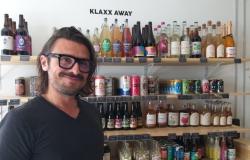“Sinnamary, Iracoubo and Régina”: Philippe Dorelon, head of the territorial service of INSEE Guyana, lists three of the 22 municipalities in the French territory of South America. Three municipalities located on the Guyanese coast, more populated and equipped with better infrastructure, yet emblematic of the desertification which affects this overseas community.
Halfway between Cayenne and Saint-Laurent-du-Maroni, Iracoubo offers only three grocery stores and a few food stands. Jean-Guy Férol, 37, makes a living there, but wants to leave. “There is no development, no movement“, he says, regretting that with a bicycle as the only means of transport, getting around is so difficult in a region where public transport is poorly developed.
On the other side of the national road which divides the town in two, Firmin Koizé crosses the square to go to the grocery store. At 32, he took on irregular jobs. He also wants to move, but doesn’t know where he could settle. One thing is certain: “I won’t stay in Iracoubo forever.”
A desire common to many young Guyanese dreaming of leaving for Kourou, Cayenne or France. Since the beginning of the 2000s, Iracoubo has continued to lose inhabitants: from 2,000 in 2009, there were barely more than 1,700 in 2020, according to INSEE. Over the same period, Guyana increased from 224,000 to 286,000 inhabitants, an increase mainly concentrated in the suburbs of Cayenne.
The figures speak for themselves: Matoury, a town located a few kilometers south of Cayenne and which hosts a large commercial area, gained 8,000 inhabitants when the population of Macouria increased from 7,800 souls in 2006 to 19,000 in 2021.
Lack of jobs
These departures worry Céline Régis, the mayor of Iracoubo, a coastal town further west, because they are accompanied by a disappearance of services and employment. “I knew (Iracoubo) more than twenty years ago with two or three restaurants,” remembers the city councilor.
The municipality is the first of the few employers in the town, with around fifty employees, and Céline Régis is often contacted by residents wishing to be hired. Each year, operating expenses absorb 2.1 million euros, out of a budget of 2.4 million. “There are two or three private companies, then it’s National Education”even if some of these officials live in Sinnamary, she sighs.
Crossed by the river of the same name, Sinnamary, 30 km east of Iracoubo, is however not better off: from 3,200 inhabitants in 2009, the population increased to 2,800 in 2020.
The banks of the river, in the shade of imposing mango trees, are deserted. The causes are identical: lack of work and the need to leave to continue their studies prompts the departure. “There is no high school in Sinnamary: once the children have finished middle school, people leave to find a life elsewhere,” regrette Christian Clet, first deputy mayor.
Until recently, major projects such as the Petit-Saut dam, which supplies two-thirds of the homes on the Guyanese coast, had helped the town’s demography. Once the construction site was completed, many workers left.
The city suffered another hard blow in 2022: the departure of the 300 Russians who worked at the space center straddling Kourou and Sinnamary, due to the outbreak of war in Ukraine.
The impact is not only demographic: these departures also affect the finances of cities. The overall operating allocation “is paid according to the number of inhabitants”, recalls Christian Clet.
Between 2018 and 2020, that of Sinnamary fell by 20%, before starting to rise again thanks to a boost from the State.
For the moment, reassures Philippe Dorelon, the positive natural balance, with “more births than deaths in these municipalities” thanks to a very young Guyanese population, allows these municipalities to withstand the shock. But the risk, he adds, is that the phenomenon will be reversed. Like Martinique and Guadeloupe, two regions set to become the oldest in France in the years to come.
With AFP





